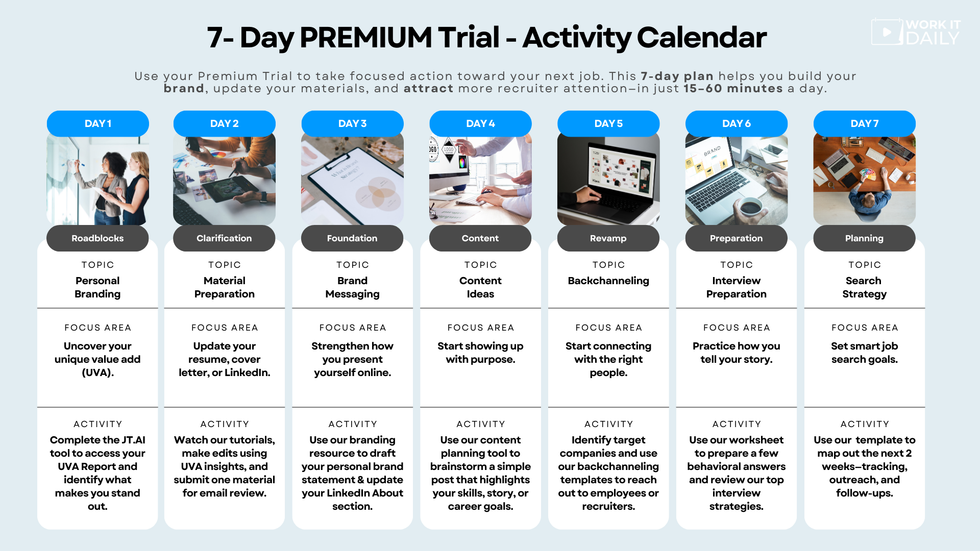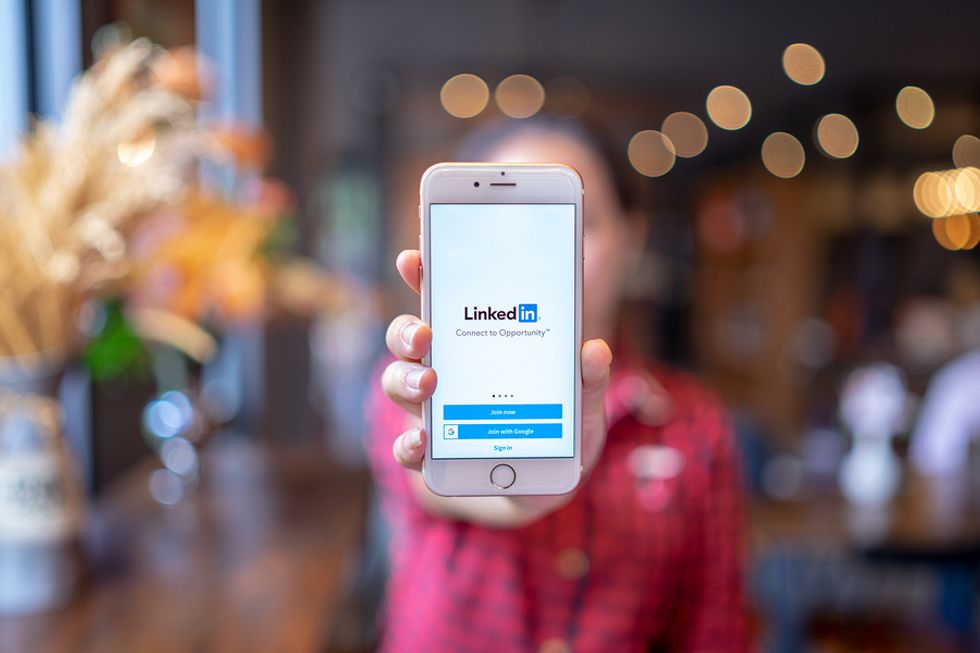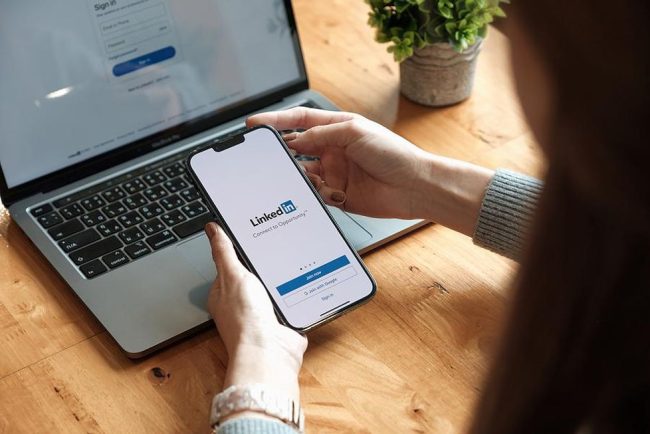
by Admin
How To Write A Cover Letter Recruiters Will LOVE
True or false: Recruiters don’t read cover letters. Most job seekers assume this is true and that writing one is just a waste of time. But here’s the truth: recruiters do read cover letters—when they’re written well. So, what does that tell us? If most […]
Career development
by Admin
Why Feedback Will Help Your Professional Development
Feedback, in the world of business, is the breakfast of champions. Feedback “feeds” us. It’s at the top of the food pyramid for learning and professional development. If you’re not actively seeking it, you’re missing out on one of the most powerful tools for career […]
Career development
by Admin
4 Ways To Upgrade Your LinkedIn Presence
LinkedIn can be an extremely valuable resource in your job search if you know how to use it properly. Whether it’s using LinkedIn to make a new connection and earn a job referral or to try to get noticed by recruiters, there are ways to […]
Career development


How Recent Grads Can Quantify Their Accomplishments
by Admin
Quantifying your accomplishments on a resume is very important since employers do not make important hiring decisions based on qualifications only. Recent college graduates often struggle with how to quantify their accomplishments. However, accomplishments aren’t only about big numbers. Anything that contributes to the company’s […]
Career development
Quantifying your accomplishments on a resume is very important since employers do not make important hiring decisions based on qualifications only. Recent college graduates often struggle with how to quantify their accomplishments. However, accomplishments aren’t only about big numbers. Anything that contributes to the company’s goals is an achievement.
How To Quantify Your Accomplishments As A Recent College Grad
Even as an intern or recent college graduate, changing a process to improve the ease or speed of a task is an accomplishment. You should be able to find some achievements from your course or work experience. It is easy to impress the interviewer with examples of increasing profits, decreasing costs, or streamlining processes.
When asked about accomplishments, don’t say clichés answers like, “I got 2:1,” or “I got a driver’s license.” Having a degree is hardly going to make you stand out from the crowd. Ideally, you would want to mention something tangible that you can measure (e.g., if you raised money for charity, how much did you raise in the end?).
As with competency-based interviews that usually focus on behavioral questions, you should aim to use the “Experience + Learn = Grow” technique when quantifying your accomplishments.
- Experience: Give the interviewer some context. Describe the experience (challenges, goals, your methodology, etc.) and why the accomplishment was significant. Why was it difficult to achieve?
- Learn: What did you learn from this experience? Think about the skills you developed, the knowledge you gained.
- Grow: How did you grow from this experience? What was the outcome? Make sure it is specific. If you’ve saved time or money or received great feedback, say it. Let the interviewer know you get results and learn from your mistakes and successes.
If you’re still struggling to come up with something, think about whether you’ve done any of these:
- Trained for and finally completed a marathon or other sporting achievement.
- Set up a new student society or turned a struggling one into something more successful.
- Overcame a fear by completing something you were frightened of.
- Gave a presentation at an event and got over public speaking worries.
- Raised a certain amount of money for charity.
- Helped others succeed by teaching them a new skill.
Here are some examples of quantified accomplishments for recent college grads:
- Worked as a part of a team of students who created a multi-media campaign that increased student enrollment by 45%.
- Named class representative of 5,000 students during final year at college, owing to consistently acquiring “A” grades and exceptional personal conduct.
- Streamlined 3 university admissions office procedures by introducing centralized online enrollment procedures.
- Received 8 awards for drama and music during the 4 years spent at college.
- Attained the Dean’s Award for Excellence following distinctions in 5 languages and 3 sports.
You can choose a professional accomplishment that’s related to the role, such as exceeding sales targets in your part-time job, but you don’t have to. It’s more important that it’s an achievement you’re genuinely proud of.
Good luck quantifying your accomplishments on your resume! We’re here for you if you need any more help navigating the post-grad job search.
Need Help Landing Your First Job Out Of College?
Join our Free Resource Center today to learn how to use your personality and passion to get hired. It’s the best free resource you’ll use in your job search—and the only one you need to land your first job.

by Admin
3 BIG Resume Mistakes (That Are Easy To Fix)
When you’re looking for a new job, your resume is your calling card. It’s often the first impression a potential employer will have of you, and in today’s competitive job market, you can’t afford to get it wrong. A strong, well-crafted resume can open doors, […]
Career development
When you’re looking for a new job, your resume is your calling card. It’s often the first impression a potential employer will have of you, and in today’s competitive job market, you can’t afford to get it wrong. A strong, well-crafted resume can open doors, while a sloppy one can quickly close them. Unfortunately, many job seekers make simple resume mistakes that end up costing them interviews.
When most people think of mistakes, they think of misspelled words, poor formatting, and obvious typos. These things are easy to avoid by proofreading your documents thoroughly. But what about the subtle, often overlooked errors that send the wrong message to recruiters? These common resume mistakes may not seem like a big deal, but they can seriously hurt your chances of landing a job. The good news? They’re all easy to fix—once you know what to look for.
Here are three of the biggest resume mistakes to avoid:
Inconsistencies
The first thing a recruiter is likely to do after receiving your resume is check you out on LinkedIn. This is often when inconsistencies crop up because the information on your resume might not match the information on your LinkedIn profile. This is not to say that your resume and LinkedIn profile should be mirror images. But they should match when it comes to current and past employers, job titles, and dates of employment.
Unfortunately, when candidates prepare a resume, they often “lump” all their work at an employer under their current (and likely most prestigious) title. This is bad for two reasons. First, it fails to show career advancement. Second, it makes employers wonder what other inaccuracies they may find.
It’s important to break out each role you’ve held at a company with its own title, set of dates, and bullet points describing your achievements. If your resume lacks this structure, recruiters may overlook valuable experience simply because it’s not clearly presented. Take the time to align your resume and LinkedIn profile; doing so builds credibility and makes your job history easier to understand at a glance.
Incomplete Contact Information

This may seem like a no-brainer, but some people are so focused on the meat of their resume that they forget to include their contact info. When you’re looking for a job, it’s important to make it easy for interested parties to contact you. Some recruiters prefer to contact candidates via email. Others would rather just call.
Of course, if they really want to contact you, it’s not impossible to find your phone number or email address. But why would you want to make a potential employer jump through hoops? Be respectful of the preferred communication styles of others by providing complete contact information. While you’re at it, put your LinkedIn URL on your resume, too.
Including a professional LinkedIn profile link boosts your credibility and gives hiring managers easy access to a deeper look at your experience, recommendations, and endorsements. Plus, optimizing your resume for recruiter accessibility is key; if they can’t reach you quickly, they’ll move on to someone they can. Double-check that your contact details are up to date and easy to spot—ideally at the top of your resume—to avoid missing out on opportunities simply because you were hard to find.
Irrelevant Information

Resumes that highlight outside activities that directly contradict a candidate’s job aspirations are just a waste of valuable space! Think of an accountant with a side business designing jewelry. Or resumes that include sports activities, like being on the soccer team, when the candidate graduated 15 years ago. While you’re at it, unless you graduated in the last five years, there’s no reason to include graduation dates or your GPA.
Besides being irrelevant, including a few lines about leading your college team to victory (unless you’re a recent grad) takes up valuable space that could be used to focus on your skills and achievements—things employers actually care about!
Your resume needs to make a good first impression, one that will make a recruiter or hiring manager want to learn more and possibly contact you for an interview. Don’t waste space with irrelevant information. Don’t confuse them with inconsistencies or make them go into detective mode to find you. Begin your relationship with a potential employer as the candidate to beat.
Need more help with your job search?
Get access to our Free Resource Center today (no credit card required!).

by Admin
#1 Communication Sin That Is Hurting Your Career
A good friend reached out to me regarding a problem he was having at work. Let’s call him Bill. Bill was part of a project team that was working on a hot new service his company wanted to create for their existing customers. He was […]
Career development
A good friend reached out to me regarding a problem he was having at work. Let’s call him Bill. Bill was part of a project team that was working on a hot new service his company wanted to create for their existing customers. He was chosen to be on the team because he manages the billing for the company. So, the project leader thought it might be good to have someone from accounting on the team as a way to make sure that whatever they came up with, the department knew what and why they charged for the service the way they did. Sounded like a great reason and a smart project leader to me, but then Bill explained the problem…
“At the first team meeting, I was nervous and didn’t want to say anything stupid. It’s the first time I’ve been invited to work on one of these teams for the company, and I’ve been working there for three years. So, I just listened carefully and took notes. The rest of the team was talking widely and brainstorming ideas. It was almost too hard to keep up. At the end of the session, the project leader looked at me and said, ‘Bill, do you have any thoughts you want to share?’ I did have some things going through my mind—mostly, a lot of clarification questions about the project, but I decided to hold off for the time being, and I just said, ‘No.’ Well, since then, I’ve found out there have been several impromptu team meetings that I wasn’t invited to. Instead, I just get an email afterward recapping what was discussed at the meeting and the next steps they are taking. It’s like I’m invisible.”
As soon as he was finished, I told Bill that he had made the “#1 Communication Sin”—and he needed to fix it fast.
#1 Communication Sin: Failure To Communicate Your Value
When Bill passed on the opportunity to speak in that first team meeting, he basically said to his teammates, “I have no reason for being here.” It was as if he admitted to the rest of the team that he was out of his league and had nothing of value to contribute.
Now, we know that’s not true. In fact, Bill’s mind was swirling with questions he wanted answers to—a clear sign that his experience was telling him there were things that needed to be defined. Yet, out of fear of appearing stupid, he didn’t ask them. And that, my friends, actually made him look worse!
The Right Approach: Articulate Your Concerns & Buy Time

I can appreciate why Bill didn’t want to pelt the group with his questions. I actually think he was wise not to. But he should have let the group know that his silence in the meeting was by no means an indicator of him not having anything to contribute. Instead, he should have used that to his advantage by saying, “I actually have a lot of thoughts and questions swirling in my head right now as it relates to how you can price this product and invoice them effectively. What I’d like to do is take some time to write them out and send them to the team by email. That way, we can wrap this meeting up and keep things moving forward.”
This simple statement would have given Bill the chance to explain his thoughtful nature and buy him some time so he could process his thoughts and then share them with the team in a way he felt comfortable doing.
My suggestion for fixing the current problem was simple: Go to the project manager with a list of thoughts and suggestions and ask for permission to discuss them with the team at the next meeting. This would give Bill a chance to prepare and would force the project manager to include him in the next meeting. From there, Bill could re-establish his role on the team and start to engage them as a way to prove his value.
FACT: Your Interaction Style Impacts Your Career Success

One of the reasons Bill struggled in this situation is that he has a Contemplator interaction style. This style tends to be more reserved in their workplace communications. The style is known for being calming and patient, but it also can be misperceived as aloof or unaware.
Interaction styles are at the root of all communication sins made today. In Bill’s case, his style hurt his credibility with his peers.
Don’t Be A Communication Sinner. Learn To Interact Like A Pro!
When it comes to communication, you can’t afford not to improve your skills in today’s competitive workplace. Take our UVA Quiz in our Free Resource Center and learn how to leverage your interaction style—so you can get the respect you want and deserve!

by Admin
Workplace Disagreements: How To Handle Them The Right Way
The workplace is a dynamic place. Unfortunately, any time multiple human beings get together, there is potential for conflict. Disagreements in the workplace can be unpleasant. Assuming two people are at odds with one another, that negative vibe can quickly spread through a team or […]
Career development
The workplace is a dynamic place. Unfortunately, any time multiple human beings get together, there is potential for conflict.
Disagreements in the workplace can be unpleasant. Assuming two people are at odds with one another, that negative vibe can quickly spread through a team or organization. It is almost a guarantee that in each career, some disagreements will arise. It would be impossible to always agree on strategy and tactics with colleagues. It would also be counterproductive to always have agreement in the workplace.
Encouraging and promoting different ideas and perspectives is key to coming up with solutions and teams performing at high levels.
The task becomes determining if a disagreement is healthy. If it is unhealthy, it can be difficult to diagnose and solve the problem. No matter how much people say, “Let it go, it’s just work,” that is easier said than done. When people put so much into their careers and jobs, it’s worth it to try to understand disagreements and learn how to manage disagreements in the workplace.
Navigating these quarrels can go a long way toward saving or strengthening relationships and improving one’s professional reputation.
Try The Mirror Before The Window
For starters, when there is a disagreement in the workplace, look in the mirror before peering out the window. In other words, reflect on your actions and perspective before focusing on what others may have done wrong. This self-awareness can help you better manage workplace conflict and respond thoughtfully rather than react impulsively.
In fact, this advice is helpful in many professional settings, especially when dealing with communication issues or team tension. Something to keep in mind is that, in most disagreements, each side genuinely believes they are doing the right thing. Each person’s stance can be completely foreign to the other, but if the conflict is approached with an attempt at understanding and mutual respect, a positive resolution is more likely.
Practicing active listening, staying calm, and focusing on shared goals are essential strategies for handling workplace disagreements the right way. Not only does this build trust, but it also contributes to a more collaborative and productive work environment.
Talk To A Mentor

Having someone to talk to about the matter can be helpful. Someone who is removed from the situation can be trusted and is discreet. If this person can bring a unique perspective, all the better. They can listen, ask challenging and thought-provoking questions, or maybe he or she has been there before and can offer some thoughtful advice.
However, choose a confidant carefully. The other side of this advice is to avoid airing grievances in the workplace. Always attempt to take the high road. Talking too much to too many people can not only be counterproductive and damage relationships, but it can also be harmful to one’s reputation.
The point of talking to someone about the situation is to help you assess your perspective.
Take A Positive Approach

After reflecting on a disagreement, as uncomfortable as it may be, it is almost always most productive to sit down with the other party.
Rather than approach the meeting as adversarial, go into it seeking to understand, make progress, and find a resolution. Ask thoughtful questions to clarify each other’s viewpoints, and actively listen without interrupting. Try to help each other see the other’s perspective. If there is a commitment to compromise and flexibility upfront, good things often happen.
Engage A Facilitator

Good intentions alone may not help. In the event that addressing the disagreement head-on is not successful or the other party is not receptive, it may be helpful to engage a third-party facilitator. The facilitator may need to serve as a mediator, or the person may be helpful in creating a more constructive meeting environment. Either way, there is often value in having someone objective and removed from the situation to provide another set of eyes and ears. In order to be most effective, the facilitator should be someone both parties agree on and want to participate.
Many organizations have HR or organizational development consultants in-house who can serve this purpose. Smaller employers may not have that luxury, but there may still be an HR professional or other trusted resource equipped to help the situation. The point is, this person will need to be credible, respected, and willing to provide candid feedback.
Disagreements at work are going to happen. In many instances, disagreements are productive and good signs of diverse thought. They do not need to be the end of the world, but the ones that matter cannot be allowed to fester. Working in an environment where there is hesitancy to disagree or offer an alternative can squash creativity and add unnecessary stress.
When disagreements crop up, it’s important to stay professional, reflect on each side’s perspective, and try to find the best solution possible for the good of everyone involved. It can be tricky at first, but once you know how to resolve disagreements in the workplace, dealing with co-workers becomes much easier. No two situations are going to be alike, but by taking a measured, collaborative approach, even the toughest hurdles can be overcome.
Need more help with your career?
Get access to our Free Resource Center today (no credit card required!).

by Admin
Challenge: Shut Down Negative Self-Talk (NST)
Today’s Work It DAILY challenge is simple, but powerful: Shut down negative self-talk. We all have that inner voice—the one that whispers doubts, exaggerates mistakes, and chips away at our confidence. For many professionals, especially job seekers and those navigating career transitions, this voice can […]
Career development
Today’s Work It DAILY challenge is simple, but powerful: Shut down negative self-talk.
We all have that inner voice—the one that whispers doubts, exaggerates mistakes, and chips away at our confidence. For many professionals, especially job seekers and those navigating career transitions, this voice can be relentless.
But here’s the truth: If you let your inner critic call the shots, it will hold you back from the success you’re working so hard to achieve.
When something goes wrong—you bomb an interview, make a mistake on a project, or get passed over for a promotion—it’s easy to beat yourself up. You might find yourself thinking things like:
- “I’m terrible at interviews. I’ll never get hired.”
- “I always mess things up.”
- “I’m not cut out for this.”
While it’s important to be responsible for your actions and take accountability for what you can control, there’s a big difference between “I suck at interviews and will never get better!” and “I need to do more interview prep next time.”
It’s easy to let that negative emotion consume you. You’re frustrated. You’re emotional. You wanted a different outcome. However, it’s important for both your personal well-being and professional success to practice shutting down this overly critical voice in your head.
These kinds of thoughts might feel honest in the moment, but they’re not helpful. In fact, this kind of negative self-talk will bring down your mood, drain your motivation, and erode your confidence.
When you lack confidence, others can sense it. And if you don’t believe in your potential, why would a hiring manager?
How to Stop Negative Self-Talk
The key is to reframe.
There’s a big difference between “I’ll never be good at this” and “I need to practice this skill more.” One shuts down growth. The other opens the door to improvement.
Let’s say you’re frustrated because your co-worker Bob got the promotion you were hoping for. Instead of thinking:
“I must be terrible at my job. No matter how hard I work, it’s not enough.”
Try reframing it:
“I’m disappointed, but I’ll use this as motivation to grow. What can I improve before the next opportunity?”
It’s okay to feel frustration, disappointment, or even anger, but don’t let those emotions write the story of your career.
The Reframing Challenge

Every time a negative thought about yourself pops into your head today, pause and then reframe it. Turn that critical voice into a coaching voice. Make it actionable. Make it constructive.
Here’s a simple formula to try:
NST Thought: “I failed that interview.”
Reframed Thought: “That interview didn’t go well. What can I learn from it to do better next time?”
Small shifts like this can have a big impact on your mindset, energy, and overall outlook.
Your Turn

How do you silence your inner critic? What strategies have helped you reframe negative thoughts? Share your tips on LinkedIn and tag us in the post—we’d love to hear from you!
And if you’re struggling to break the cycle of negative self-talk, you’re not alone. Our coaching team at Work It DAILY can help you develop the tools, habits, and mindset shifts needed to overcome self-doubt and move forward with clarity and confidence.
Sign up for a free trial today and start shutting down those negative thoughts!

by Admin
4 Phrases You Should Never Have On Your Resume
Sometimes, the reason your resume gets dismissed by employers has nothing to do with your experience or qualifications. It could simply come down to using phrases that immediately turn hiring managers off. Every word on your resume must work for you, not against you. In […]
Career development
Sometimes, the reason your resume gets dismissed by employers has nothing to do with your experience or qualifications. It could simply come down to using phrases that immediately turn hiring managers off. Every word on your resume must work for you, not against you.
In addition to steering clear of generic buzzwords like “creative,” “innovative,” “visionary,” “team player,” “motivated,” “highly skilled,” “hard worker,” “passionate,” and “driven”—which offer no real insight into your actual value—you should also eliminate specific phrases that raise red flags or waste space. These common resume mistakes can make even the most qualified candidates seem unpolished or out of touch.
If you want to make a strong first impression, avoid these top resume phrases at all costs:
“Job Duties”
“Job duties” essentially says to the employer that these are my responsibilities on the job. Well, that’s fine if the only one you need to impress is the applicant tracking system (ATS) looking for matches in the job description.
The problem with including this phrase on your resume is that it doesn’t inform the hiring manager how well you perform on the job, and they ultimately have the final say as to whether your resume is a keeper or not.
A more effective phrase to use is “accomplishments” to describe your work experience. You want to inform the employer of what you did on the job and prove that what you did produced valuable results. You always need to quantify your accomplishments on your resume. The first step in quantifying your accomplishments on your resume is getting rid of the phrase “job duties.”
“Transferable Skills”

While professional resume writers speak of highlighting “transferable skills” on your resume when you’re looking to make a career change or when you don’t have the exact work experience the employer may be looking for, the specific term should be avoided on your resume.
When hiring managers and recruiters see “transferable skills” on a resume, it basically sends the message “I don’t have the exact experience or hard skills you’re looking for, but…”
A more effective phrase to use is “skills” or “skill set” or even “experience summary” (see below). It doesn’t bring attention to the fact that you aren’t a direct match with what they are looking for, but goes straight to the point of what you can offer that is of value to them. Using clear and direct language that emphasizes relevant expertise helps your resume pass both human and applicant tracking system (ATS) reviews
“Objective Statement”

Traditionally, the objective statement takes a prime spot at the top of the resume detailing what you, the job seeker, are looking for—but that’s no way to compete in today’s job market. The opening of your resume needs to make a bold statement, informing the employer what you can do for them.
Replace an objective statement with an experience summary, which is a list of 6-8 hard or transferable skills needed for the specific job you’re applying for. This section quickly communicates your value and aligns your background with the employer’s needs. Hiring managers scan resumes in seconds, so lead with measurable achievements, relevant keywords, and industry-specific skills.
“References Available Upon Request”

You can assume all employers will go through a reference check before they hire you. Including this phrase on your resume is simply a waste of space and makes your resume come across as outdated, since it was common practice to include it at the end of the resume years ago, before applicant tracking systems and AI changed the landscape of the job search process.
Today’s job seekers need a well-polished resume to compete. Avoiding overused buzzwords and phrases that say nothing or that may imply something negative will help keep you in the running.
We know today’s hiring managers get more applicants than needed for each job opening, so don’t let bad phrases be the cause for them turning away your resume! By eliminating vague language and replacing it with strong, results-driven statements, you’ll create a resume that stands out in today’s competitive job market.
Need more help with your job search?
Get access to our Free Resource Center today (no credit card required!).

by Admin
How To Start A Conversation With A LinkedIn Connection
You just got a new LinkedIn connection—woo-hoo! Okay, now what? How can you start building your professional relationship with this person so you add value to each other’s network? Making that first move can feel a little awkward, but it’s a key step in turning […]
Career development
You just got a new LinkedIn connection—woo-hoo! Okay, now what? How can you start building your professional relationship with this person so you add value to each other’s network?
Making that first move can feel a little awkward, but it’s a key step in turning a simple connection into a meaningful professional relationship. Whether you’re networking for a job search, looking for collaborators, or simply expanding your industry circle, learning how to start a conversation on LinkedIn can open doors to new opportunities.
Here are some tips for getting a dialogue started with new LinkedIn connections…
1. Start With Your Subject Line
If you’re having trouble thinking of what to say in your initial message to your new LinkedIn connection, start with your subject line and then elaborate.
You can say something as simple as “Thanks for connecting!” or even “It’s great to meet you!” If you enjoyed an article they wrote or shared, you can say something like, “Loved your article!” or “Thanks for sharing your insight!”
If you met your new LinkedIn connection in person at a networking event, mention something specific like, “It was great to meet you yesterday at the ABC Event!” or “Wanted to continue our conversation from yesterday.” These personal touches help break the ice and show genuine interest, which is key to building meaningful professional relationships on LinkedIn.
2. Introduce (Or Reintroduce) Yourself
Send your new connections a brief message to introduce yourself, or reintroduce yourself if you’ve previously met. This will give them a refresher and will help jog their memory from when you last spoke.
Keep it concise and focused, avoiding generic or overly formal language. A clear, thoughtful introduction sets the tone for a positive and professional LinkedIn connection.
3. Mention Things You Have In Common
Take a look at your new LinkedIn connection’s profile and see what you have in common. Do you share a similar skill set? Do you volunteer for the same organization?
Mentioning a shared interest, alma mater, or industry experience is a great way to personalize your message and show genuine interest. Find something you share and start a conversation around it. It will make it easier for you to break into a real dialogue. Plus, it will help build a stronger personal connection between the two of you.
You can say something like, “I noticed we both worked in SaaS startups—I’d love to hear your take on where the industry is heading.” Starting with something specific makes your outreach feel less like a cold message and more like a thoughtful networking conversation.
4. Offer Your Support
In order to have a strong network, you need to constantly offer value to it. When you meet a new connection, make it clear that you’ll be a valuable contributor to their network.
You can say something like, “Please let me know how I can help you achieve your goals,” or “I’d be happy to support you in any way I can.” Simple, authentic gestures like these open the door to meaningful conversations on LinkedIn.
5. Don’t Ask For Favors Just Yet
Don’t ask for anything right off the bat. It makes you look greedy.
It’s important to build a relationship with this person before you ask for any favors. They’ll be more likely to help you out once they know who you are and that you’ll return the favor.
Don’t be afraid to start a conversation with a LinkedIn connection ever again. Use these tips, and you’ll successfully grow your professional network. The more genuine and intentional your outreach, the more likely you’ll make a lasting impression. Keep practicing your LinkedIn messaging strategy, and soon it will feel like second nature.
Need more help with your career?
Get access to our Free Resource Center today (no credit card required!).

by Admin
4 Things To Do: Getting A New Job While Working
Do you want to quit your job but don’t feel comfortable giving your two weeks’ notice until you’ve secured a new position? You’re not alone—and the good news is, it’s absolutely possible to find a new job while you’re still employed. In fact, conducting a […]
Career development
Do you want to quit your job but don’t feel comfortable giving your two weeks’ notice until you’ve secured a new position? You’re not alone—and the good news is, it’s absolutely possible to find a new job while you’re still employed. In fact, conducting a job search while working can give you more leverage in interviews, allow you to avoid employment gaps, and keep your financial situation stable during the transition.
One of our Work It DAILY fans recently asked, “Hey, I want to leave my current job and start something new. What should be on my to-do list today?”
If you’re wondering how to get a new job while working full-time, I’m going to walk you through four essential steps that will help you land your next role, without risking your current one.
Referrals Matter

Now, before I begin, I want to remind you of an important fact. In the United States, 30 to 50% of all jobs are obtained via referral. So, blindly applying online is not going to work for you. Only 3% of the people who apply online ever get called by recruiters or hiring managers.
The four steps that I’m going to outline for you are going to help you go around that ATS (applicant tracking system) and connect with recruiters and hiring managers so you stand out as a great job candidate.
So, let’s break it down…
Step 1: Inventory Your Skills

You need to inventory your transferable skills. These are all the hard skills that will be helpful in your next job. You may perform some or all of these things in a future position.
Make a detailed list of your core competencies, such as project management, data analysis, customer service, or technical writing. Identifying transferable skills is an essential step in your strategy for getting a new job while working full-time.
Step 2: Get On LinkedIn

You’re going to take those transferable skills you’ve identified and make sure they’re optimized on both your resume and your LinkedIn profile.
Recruiters are always searching for those key terms when looking for potential job candidates, so if you have your transferable skills listed on your LinkedIn profile (in your LinkedIn headline, for example) you’re going to improve your chances that they’ll connect with you and reach out to you about job opportunities you’re a fit for. You should also weave these keywords into your LinkedIn “About” section and work experience descriptions to further boost visibility in search results.
Additionally, tailoring your resume for each job application by aligning your transferable skills with the specific requirements of the job description will help you stand out to hiring managers. The more aligned your online presence is with your target roles, the more likely you are to be discovered while you’re still employed.
Step 3: Make A Bucket List

Next, create what’s called an interview bucket list. This is a list of 10 to 20 companies that you would love to work for and that hire for your skill sets.
The best way to build an interview bucket list is to research companies you admire and would love to work for. Make sure you’d be able to either commute to or work remotely for these companies. If your skills also match the jobs they hire for, the company belongs on your interview bucket list!
This list will help you stay focused and intentional during your job search, especially when time is limited. Look at each company’s career page, follow them on LinkedIn, and set up job alerts so you’re the first to know when relevant positions open up. By proactively targeting companies that align with your goals and values, you’ll increase your chances of landing a new job while working full-time.
Step 4: Identify People At Your Bucket List Companies

Finally, start connecting with professionals who currently work at the companies on your interview bucket list. These insider connections can provide valuable insights into the company culture, hiring process, and what it takes to stand out as a candidate. Tap into your existing network—friends, former colleagues, alumni, or LinkedIn connections—to see if anyone can offer referrals or introduce you to key decision-makers.
Informational interviews with current employees not only help you tailor your resume and cover letter for specific roles but also increase your chances of accessing the hidden job market. Building genuine relationships with people on the inside (aka backchanneling!) is one of the most effective ways to get a new job—employed or unemployed.
The Most Efficient Way To Find A New Job
This brings me back to my very first point about getting referred to companies. This is the best, fastest, most efficient way for you to find a new job while employed because you don’t have time all day to spend on your job search. Work smarter, not harder!
Need more help with your job search?
Get access to our Free Resource Center today (no credit card required!).

by Admin
How To End Your Week On A Positive Note
As the workweek comes to a close (for most of us), I want to share a set of habits that have become an end-of-the-week routine for me. This routine has been key to ending my week on a positive note and “teeing up” a great […]
Career development
As the workweek comes to a close (for most of us), I want to share a set of habits that have become an end-of-the-week routine for me. This routine has been key to ending my week on a positive note and “teeing up” a great start to the following week.
So, how do you end your week on a positive note? As we say at Work It DAILY, it’s all about creating good habits. When you take time to wrap up your week with intention, you reduce stress, gain clarity, and feel more in control heading into Monday.
Consider doing these three things before you leave work each Friday:
Habit #1: Write A Thank-You Note

Reach out with a quick email or (better yet) a short thank-you note expressing gratitude for those who went out of their way to help you this week.
This is literally a 10-minute exercise that has powerful results. You’ll feel great in expressing thanks, and the recipient will receive a nice message to end the week on. Who went out of their way to help you this week?
Ending your week with gratitude can improve your outlook, boost morale, and even set the stage for a more productive Monday.
Habit #2: Reflect On Your Accomplishments

Make note of what you believe were your three greatest accomplishments over the past week. Embrace the sense of satisfaction and positive emotion associated with getting these important things done. Reflecting on your weekly wins is a powerful way to build momentum and confidence in your professional journey.
Connect this habit with the one above. Was there anyone who contributed significantly to your three greatest achievements? Follow up or reach out to those people with a word of thanks.
Habit #3: Set Goals For Next Week

What are your three most important goals for next week? Write them down before you log off or leave the office, and visualize yourself reaching those goals. Think about what it will take for you to be successful the following week.
Do you have sufficient time set aside to accomplish those goals? Who do you need to solicit for help? (Go ahead and reach out and confirm their participation before you end this week.) What is the very next action associated with each of those goals, and do you have that task clearly identified on your calendar or task list with a due date?
Break your goals into manageable steps to reduce overwhelm and increase your chances of follow-through. Ending the week with a plan boosts motivation, helps reduce Sunday night anxiety, and sets you up for a more productive and focused Monday.
Give these habits a try on Friday afternoons. If you see a positive effect, add other ones that are relevant to your situation. The message here is to begin a weekly routine that will help you end the week in a positive way and help you get clarity on the most important things for next week.
Need more help with your career?
Get access to our Free Resource Center today (no credit card required!).

by Admin
How To Build A STRONG LinkedIn Profile
The job search process is always evolving. It’s not about going to the job boards, finding the job opening you like, and then applying for it. That method will only have you waiting by the phone for a call, which is likely not going to […]
Career development
The job search process is always evolving. It’s not about going to the job boards, finding the job opening you like, and then applying for it. That method will only have you waiting by the phone for a call, which is likely not going to happen. Today’s job seekers need to take a more proactive and interactive approach called “backchanneling” (a type of professional networking), and LinkedIn is a resource to help you do that. That’s why you need an optimized LinkedIn profile for job search success.
Creating a strong LinkedIn profile will help you get in front of the right contacts (recruiters, hiring managers, professionals in the field, etc.) who can lead you to your next job opportunity. However, in order for that to happen, you need a LinkedIn profile that communicates and displays the right information.
Your profile should be keyword-optimized, visually appealing, and aligned with your personal brand. Think of it as your digital first impression—one that needs to be clear, compelling, and easy to find in LinkedIn search results.
Take a look at the LinkedIn profile checklist below to learn how to optimize and use your LinkedIn profile effectively.
The Basics Of An Effective LinkedIn Profile

1. Make Sure You Have An Appropriate Headline
The headline is what shows up for your LinkedIn profile when it comes up in search results. It’s also what shows up when others look at you through their contacts’ connections. By default, your LinkedIn headline reads your current job title and employer, but if you want to grab the attention of others, it should say more than that. Think about keywords and highlighting your greatest skill sets, each separated by a vertical line.
2. Display Professionalism In Your Profile Photo
A LinkedIn profile that includes a headshot photo is more likely to be clicked on than a profile without a photo. In selecting your profile photo, go with a headshot that makes you look professional and approachable.
3. Personalize Your LinkedIn URL
Whether you choose to include your LinkedIn profile on your resume or in your email signature, personalize the URL. It’ll come off as more professional and memorable. Examples:
- linkedin.com/yourname
- linkedin.com/yourname-professionalkeyword
The Important Details In An Effective LinkedIn Profile

1. Offer Your Value Statement In The “About” (Summary) Section
The “About” section on your LinkedIn profile should summarize what you have to offer and how that translates to value for the potential employer. This is where you’ll include your personal branding statement. This section should also contain a list of your key skill sets. Never write in the third person on your LinkedIn profile unless you want to come off as pretentious.
2. Make Your Work Experience Keyword-Rich
In your “Experience” section on your LinkedIn profile, use bullet points to highlight accomplishments and quantify your work experience. Think about relevant keywords to include naturally in your writing. The more keyword-rich your profile is, the more likely it’ll show up in search results. It’s also important to make sure the information you include in your “Experience” section on your LinkedIn profile matches the information in the “Work History” section on your resume, so you don’t confuse recruiters and hiring managers.
3. Get Endorsed For The Right Skills And Expertise
Review the “Skills and Expertise” section to prioritize what’s important. When you do that, your contacts are more likely to endorse you for the right skills, which in turn shows recruiters and hiring managers you have what they are looking for. What you want to avoid is including skills and expertise that don’t relate to the jobs you’re applying for or your profession. That will simply dilute your overall message, including your personal brand.
Additional Steps For Creating An Effective LinkedIn Profile
1. Don’t Let Your Education Give Away Your Age
Your education, which can include specialized training and certifications, adds value to your qualifications. When listing the information, take caution with dates. It’s not necessary to indicate when you received your degree from college—that can give away your age in some cases. Also, don’t include anything that may be too dated. You want to show you hold current, relevant skills that are valuable to the profession, not irrelevant expertise.
2. Join Relevant Groups
LinkedIn offers a diverse selection of Groups that you can (and should) join—professional associations, industry groups, alumni groups, etc. If they’re relevant to your profession or skills needed for the job, share their badge on your profile. It helps hiring managers and recruiters see that you’re connected and active in networks that are important. You can also benefit by taking things a step further with LinkedIn Groups, like participating in discussions and sharing interesting articles to get your name out there. Many hiring managers and recruiters will look at discussions in relevant groups to pull out potential candidates for job openings they have available.
3. Make Your Profile Public
LinkedIn profiles that are made public allow others to view your information, whether you’re connected with them or not. This option is best when you’re a job seeker.
Every professional—not just job seekers—should learn how to optimize their LinkedIn profile. A well-crafted LinkedIn profile increases your visibility to recruiters, builds your personal brand, and opens doors to new networking opportunities. Follow the steps above to build a strong LinkedIn profile today for job search and career success!
Need more help with your job search?
Get access to our Free Resource Center today (no credit card required!).



















